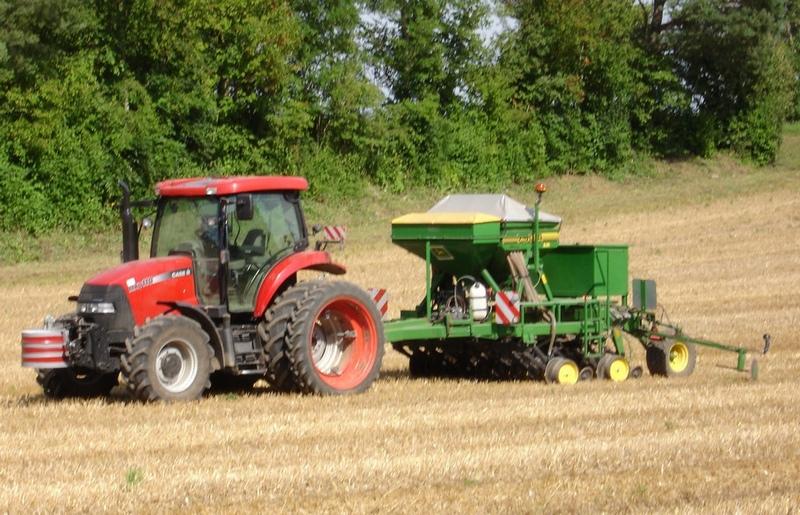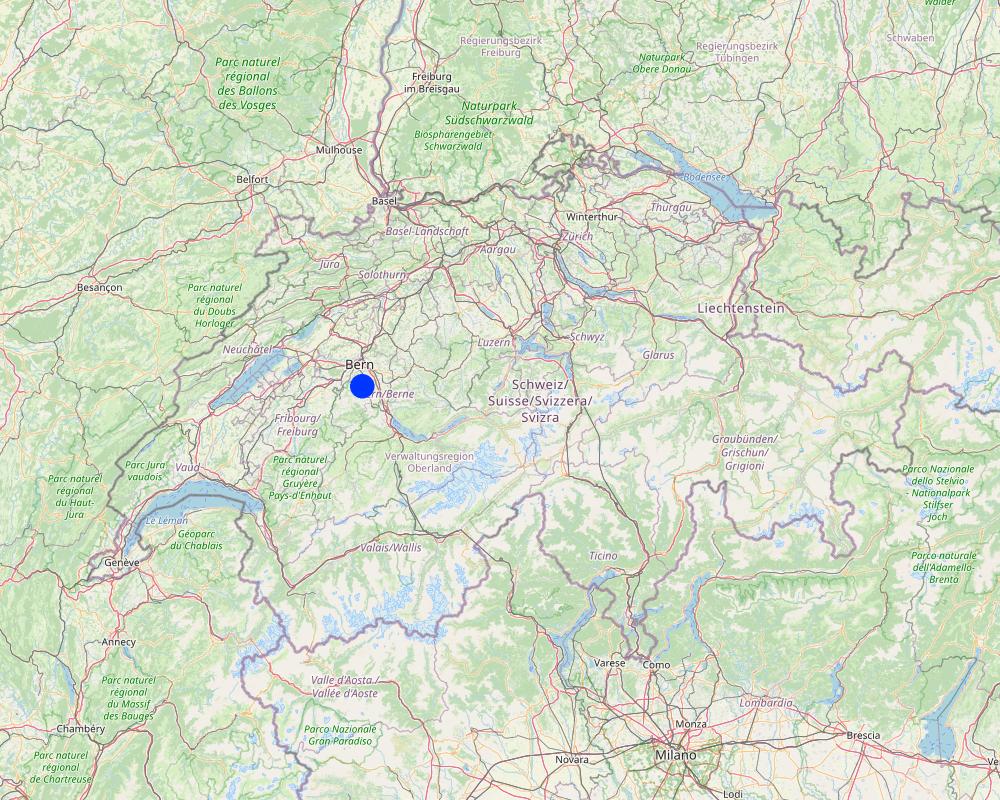Direct seeding [瑞士]
- 创建:
- 更新:
- 编制者: Unknown User
- 编辑者: –
- 审查者: Fabian Ottiger, Alexandra Gavilano, Joana Eichenberger
Direktsaat (German)
technologies_1007 - 瑞士
查看章节
全部展开 全部收起1. 一般信息
1.2 参与该技术评估和文件编制的资源人员和机构的联系方式
关键资源人
SLM专业人员:
Wyler Roman
Center for Development and Environment, University of Berne
瑞士
土地使用者:
Streit Thomas
瑞士
有助于对技术进行记录/评估的项目名称(如相关)
OPtimal strategies to retAIN and re-use water and nutrients in small agricultural catchments across different soil-climatic regions in Europe (OPTAIN)有助于对技术进行记录/评估的机构名称(如相关)
CDE Centre for Development and Environment (CDE Centre for Development and Environment) - 瑞士1.3 关于使用通过WOCAT记录的数据的条件
编制者和关键资源人员接受有关使用通过WOCAT记录数据的条件。:
是
1.5 参考关于SLM方法(使用WOCAT记录的SLM方法)的调查问卷
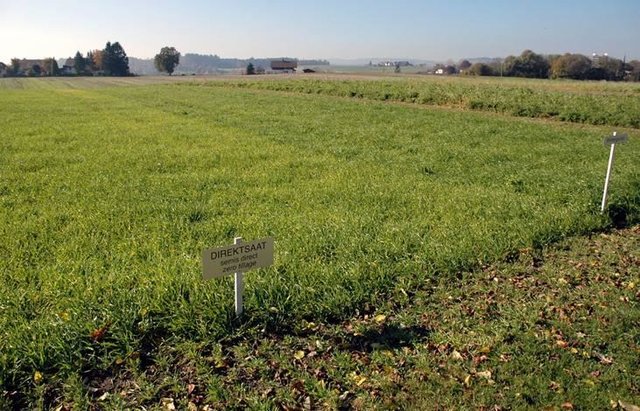
Subsidies for conservation agriculture [瑞士]
Land users commit to apply conservation agriculture on parts of their land for a period of 5 years. In return they get subsidies during this period.
- 编制者: Unknown User
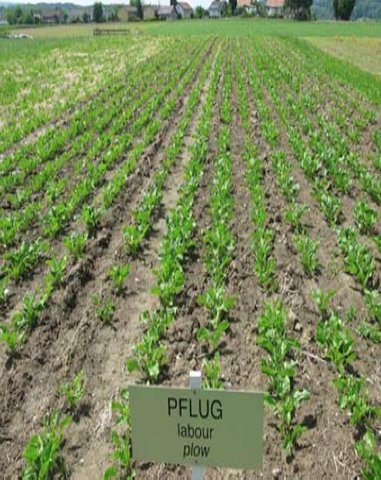
Soil support program for conservation agriculture [瑞士]
Through the soil support program land users get subsidies for applying conservation technologies on their fields during a period of 6 years.
- 编制者: Deborah Niggli
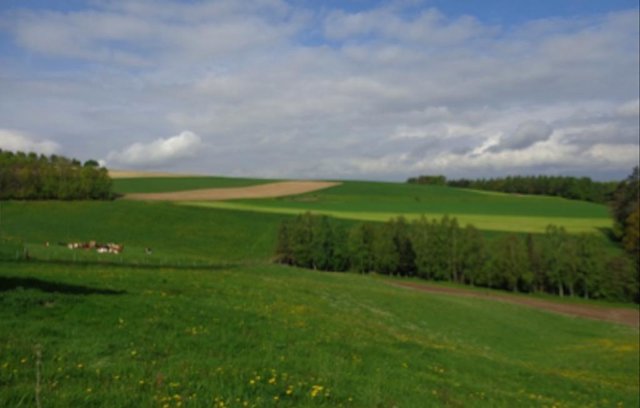
Direktzahlungssystem [瑞士]
Finanzielle Leistungen des Bundes um den Ertragsverlust, den eine Kultur für den Bauern bringt, auszugleichen. Das Direktzahlungssystem führt gewissermassen zu einer 'Vergünstigung des Produkts' für den Konsumenten.
- 编制者: Deborah Niggli
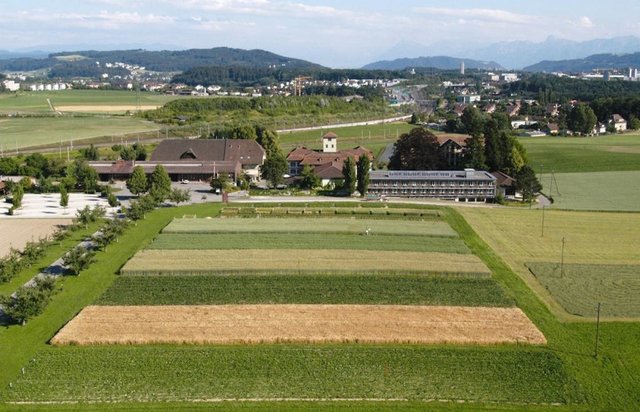
Förderprogramm Boden [瑞士]
Mit dem Förderprogramm Boden des Kantons Bern erhalten beteiligte Landnutzer Direktzahlungen für die Anwendung von bodenkonservierenden Anbauverfahren auf ihren landwirtschaftlichen Feldern. Das Projekt hat eine Dauer von 6 Jahren.
- 编制者: Deborah Niggli
2. SLM技术的说明
2.1 技术简介
技术定义:
A cropping system which allows to plant the seeds directly into the soil without ploughing. The soil is covered with plant remainders.
2.2 技术的详细说明
说明:
The farm portaited is located in a hilly area near Bern. It is cooperating with an other farm of the village so that in total 32 ha of arable land are cultivated. All crops except for potatoes and sugar beets are produced within the no-tillage system. So the area cultivated with the no-tillage system is about 26 ha. The farm is producing mainly fodder (maize, wheat) for pigs. Beside this potatoes and sugar beets are produced to be sold. A typical crop rotation consists of a root crop, followed by a winter grain and a green manure. There are major meadows, too.
No-tillage characterizes a cultivation system without ploughing or any other reworking of the soil. After the previous crop (Maize, grain) has been harvested, a total herbicide is applied and the seeds are brought directly into the soil with a special machine. A metal disk carves a narrow slit into the surface. Then the seeds are brought into the soil pneumatically. Finally, the slit is closed again by two wheels pressing on the surface.
The no-tillage system is used to reduce soil degradation, especially erosion. It enables a permanent cover of the soil surface, which reduces sealing and crusting. Since they are not disturbed by ploughing anymore, there are more earthworms in the soil. Their activity can slowly reduce compaction and improve the soil structure. This leads to better infiltration rates and also to a higher water storage capacity. Less water remains on the soil surface, so soil loss can be reduced.
The no-tillage system requires a special direct seeding machine. This machine is very expensive, so most farmers don’t buy it on their own but task a contractor with the seeding. On the other hand, certain machines from conventional agriculture are not needed anymore (plough, harrow, rotary tiller etc.). Furthermore, working hours and fuel can be saved. In some cantons of switzerland no-tillage agriculture is also subsidised. For this reason, the method holds economic advantages, too.
In the beginning crop yield may be reduced by up to 10%. The rebuilding of the soil structure requires a certain time, depending on the state of the soil at the time of transition. However, this was not the case for the farm portaited here: Already in the first year there were very good crop yields, although the probability for crop loss is higher in the no-tillage system. Competition between the crops and weeds can be too strong if the total herbicide is applied under wet conditions. In addition drying of the soil in spring is often delayed. Thus the plants may face too wet conditions.
2.3 技术照片
2.5 已应用该技术的、本评估所涵盖的国家/地区/地点
国家:
瑞士
区域/州/省:
Gemeinde Wald
有关地点的进一步说明:
Kanton Bern
注释:
The farm owns 0.27 km2. For reasons of rationalization it is working together with another farm. Together they have 0.32 km2. On 0.26 km2 direct seeding is applied.
Total area covered by the SLM Technology is 0.26 km2.
Map
×2.6 实施日期
如果不知道确切的年份,请说明大概的日期:
- 10-50年前
2.7 技术介绍
详细说明该技术是如何引入的:
- 在实验/研究期间
注释(项目类型等):
modern direct seeding was developed since the 1950s after the development of modern herbicides.
3. SLM技术的分类
3.2 应用该技术的当前土地利用类型

农田
- 一年一作
年作 - 具体指明作物:
- 饲料作物 - 草
每年的生长季节数:
- 2
具体说明:
Longest growing period in days: 230Longest growing period from month to month: Mar - OctSecond longest growing period in days: 300Second longest growing period from month to month: Nov - Aug
注释:
Major land use problems (land users’ perception): Soil erosion, soil compaction at different dephts
Future (final) land use (after implementation of SLM Technology): Cropland: Ca: Annual cropping
3.4 供水
该技术所应用土地的供水:
- 雨养
3.5 该技术所属的SLM组
- 最小的土壤扰动
3.6 包含该技术的可持续土地管理措施
3.7 该技术强调的主要土地退化类型

土壤水蚀
- Wt:表土流失/地表侵蚀

物理性土壤退化
- Pc:压实

生物性退化
- Bc:植被覆盖的减少
- Bl:土壤寿命损失
注释:
Main type of degradation addressed: Wt: loss of topsoil / surface erosion, Bc: reduction of vegetation cover, Bl: loss of soil life
Secondary types of degradation addressed: Pc: compaction
Main causes of degradation: crop management (annual, perennial, tree/shrub) (unprotected soil surface in conventional agriculture), Heavy / extreme rainfall (intensity/amounts), education, access to knowledge and support services (Tradition. In general ploughing is not questioned.)
3.8 防止、减少或恢复土地退化
具体数量名该技术与土地退化有关的目标:
- 防止土地退化
- 减少土地退化
注释:
Main goals: prevention of land degradation
Secondary goals: mitigation / reduction of land degradation
4. 技术规范、实施活动、投入和成本
4.1 该技术的技术图纸
技术规范(与技术图纸相关):
Technical knowledge required for field staff / advisors: high (the correct timing of activities is difficult to achieve. The current weather situation has a great influence.)
Technical knowledge required for land users: high (crop rotation needs to be adjusted)
Main technical functions: control of raindrop splash, improvement of ground cover, improvement of surface structure (crusting, sealing)
Secondary technical functions: improvement of topsoil structure (compaction), improvement of subsoil structure (hardpan), stabilisation of soil (eg by tree roots against land slides), increase in organic matter, increase of infiltration, increase / maintain water stored in soil
Better crop cover
Remarks: precedent crop remains on the soil
Retaining more vegetation cover
Remarks: precedent crop remains on the soilprecedent crop remains on the soil
Green manure
Remarks: no change compared to conventional agriculture
Manure / compost / residues
Material/ species: liquid pig manure
Remarks: no change compared to conventional agriculture
Mineral (inorganic) fertilizers
Remarks: no change compared to conventional agriculture
Rotations / fallows
Remarks: new crop rotation is needed
Zero tillage / no-till
Remarks: all crops except potatoes and sugar beets, where mulching is applied
4.2 有关投入和成本计算的一般信息
其它/国家货币(具体说明):
Swiss Franc
如相关,注明美元与当地货币的汇率(例如1美元=79.9巴西雷亚尔):1美元=:
1.08
4.3 技术建立活动
| 活动 | 时间(季度) | |
|---|---|---|
| 1. | Buy a direct seeding machine |
4.4 技术建立所需要的费用和投入
| 对投入进行具体说明 | 单位 | 数量 | 单位成本 | 每项投入的总成本 | 土地使用者承担的成本% | |
|---|---|---|---|---|---|---|
| 设备 | Direct seeding machine | Machine | 1.0 | 278000.0 | 278000.0 | 100.0 |
| 技术建立所需总成本 | 278000.0 | |||||
| 技术建立总成本,美元 | 257407.41 | |||||
注释:
Duration of establishment phase: 0 month(s)
4.5 维护/经常性活动
| 活动 | 时间/频率 | |
|---|---|---|
| 1. | Appliance of total herbicide (glyphosat) | 1 per growing period |
| 2. | Seeding | 1 per growing period |
| 3. | spreading of snail poison | 1-3 per growing period |
4.6 维护/经常性活动所需要的费用和投入(每年)
| 对投入进行具体说明 | 单位 | 数量 | 单位成本 | 每项投入的总成本 | 土地使用者承担的成本% | |
|---|---|---|---|---|---|---|
| 劳动力 | Seeding | ha | 1.0 | 185.0 | 185.0 | 100.0 |
| 劳动力 | Spreading of snail poison | ha | 1.0 | 46.0 | 46.0 | 100.0 |
| 肥料和杀菌剂 | Biocides | ha | 1.0 | 56.0 | 56.0 | 100.0 |
| 其它 | Appliance of herbicide | ha | 1.0 | 93.0 | 93.0 | 100.0 |
| 技术维护所需总成本 | 380.0 | |||||
| 技术维护总成本,美元 | 351.85 | |||||
注释:
New direct seeding machines usually cost $45'000. The farmer portraited bought a second hand machine for $27800. To calculate the costs it was assumed that all work is outsorced to a contracter (which is not usually the case). One growing period per year was assumed, in reality it 1-2. Worksteps which are the same in direct seeding and conventional agriculture were not included. The following worksteps are additional to conventional agriculture (working hours, costs): Appliance of total herbicide ((0.75h, $149), direct seeding (0.5h, $185), spreading of snail poison (0.5h, $83). The following steps are not needed anymore: ploughing (2.5h, $260), harrowing (1.25h, $185), conventional seeding (1h, $102). So in total about 3.75h and $130 can be saved per ha and growing period. Besides this, direct seeding is subsidised in the Canton Bern. The subsidies sum up to $250-$500 per ha and year for a period of 5 years. These subsidies are an important reason for the growing popularity of conservation agriculture in Switzerland. The most important income source for Swiss farmers are direct subsidies, which are about $1400 per ha and year. To get these subsidies, farmers have to fulfill ecological criteria.
4.7 影响成本的最重要因素
描述影响成本的最决定性因素:
The most important factor is whether a direct seeding machine can be rented in locally, because this represents a major investment.
5. 自然和人文环境
5.1 气候
年降雨量
- < 250毫米
- 251-500毫米
- 501-750毫米
- 751-1,000毫米
- 1,001-1,500毫米
- 1,501-2,000毫米
- 2,001-3,000毫米
- 3,001-4,000毫米
- > 4,000毫米
有关降雨的规范/注释:
precipitation during the whole year. The maximum lies in summer.
农业气候带
- 半湿润
Thermal climate class: temperate
5.2 地形
平均坡度:
- 水平(0-2%)
- 缓降(3-5%)
- 平缓(6-10%)
- 滚坡(11-15%)
- 崎岖(16-30%)
- 陡峭(31-60%)
- 非常陡峭(>60%)
地形:
- 高原/平原
- 山脊
- 山坡
- 山地斜坡
- 麓坡
- 谷底
垂直分布带:
- 0-100 m a.s.l.
- 101-500 m a.s.l.
- 501-1,000 m a.s.l.
- 1,001-1,500 m a.s.l.
- 1,501-2,000 m a.s.l.
- 2,001-2,500 m a.s.l.
- 2,501-3,000 m a.s.l.
- 3,001-4,000 m a.s.l.
- > 4,000 m a.s.l.
5.3 土壤
平均土层深度:
- 非常浅(0-20厘米)
- 浅(21-50厘米)
- 中等深度(51-80厘米)
- 深(81-120厘米)
- 非常深(> 120厘米)
土壤质地(表土):
- 中粒(壤土、粉土)
表土有机质:
- 高(>3%)
- 中(1-3%)
如有可能,附上完整的土壤描述或具体说明可用的信息,例如土壤类型、土壤酸碱度、阳离子交换能力、氮、盐度等。:
Soil texture is medium (loamy/silty and sandy)
Soil fertility is high
Soil drainage/infiltration is good
Soil water storage capacity is high
5.4 水资源可用性和质量
地下水位表:
5-50米
水质(未处理):
良好饮用水
关于水质和水量的注释和进一步规范:
Availability of surface water: good, medium
5.5 生物多样性
物种多样性:
- 中等
5.6 应用该技术的土地使用者的特征
生产系统的市场定位:
- 商业/市场
非农收入:
- 低于全部收入的10%
相对财富水平:
- 平均水平
个人或集体:
- 个人/家庭
机械化水平:
- 机械化/电动
性别:
- 男人
说明土地使用者的其他有关特征:
Land users applying the Technology are mainly common / average land users
Difference in the involvement of women and men: In Switzerland there are mostly men who apply the technology. However, the decision making usually takes place at the household level, including both men and women.
Population density: 50-100 persons/km2
Annual population growth: negative
Off-farm income specification: Many farmers in Switzerland have significant off farm income. But this seems to be independent of the technology applied.
5.7 应用该技术的土地使用者使用的平均土地面积
- < 0.5 公顷
- 0.5-1 公顷
- 1-2 公顷
- 2-5公顷
- 5-15公顷
- 15-50公顷
- 50-100公顷
- 100-500公顷
- 500-1,000公顷
- 1,000-10,000公顷
- > 10,000公顷
这被认为是小规模、中规模还是大规模的(参照当地实际情况)?:
- 中等规模的
5.8 土地所有权、土地使用权和水使用权
土地所有权:
- 个人,有命名
土地使用权:
- 租赁
- 个人
用水权:
- 社区(有组织)
注释:
Population growth in Switzerland is about 0.6% per year. In the commune discussed here it's about -0.6%.
5.9 进入服务和基础设施的通道
健康:
- 贫瘠
- 适度的
- 好
教育:
- 贫瘠
- 适度的
- 好
技术援助:
- 贫瘠
- 适度的
- 好
就业(例如非农):
- 贫瘠
- 适度的
- 好
市场:
- 贫瘠
- 适度的
- 好
能源:
- 贫瘠
- 适度的
- 好
道路和交通:
- 贫瘠
- 适度的
- 好
饮用水和卫生设施:
- 贫瘠
- 适度的
- 好
金融服务:
- 贫瘠
- 适度的
- 好
6. 影响和结论性说明
6.1 该技术的现场影响
社会经济效应
生产
作物生产
注释/具体说明:
not in general, but can occur in the beginning
饲料生产
生产故障风险
注释/具体说明:
reduced risk for production failure due to erosion but the technology is sensitive to wet conditions in spring. Risk of crop failure due to snails is enhanced
水资源可用性和质量
灌溉用水需求
注释/具体说明:
irrelevant in the area
收入和成本
农业投入费用
注释/具体说明:
no reworking of the soil but major initial investment if no direct seeding machine is available for rent.
农业收入
注释/具体说明:
due to reduced expenses
工作量
注释/具体说明:
no reworking of the soil
社会文化影响
文化机会
注释/具体说明:
ploughing is a major part of rural identity. Farmer become more dependent on others if work is outsourced to contractors.
生态影响
水循环/径流
地表径流
土壤
土壤水分
土壤覆盖层
土壤流失
土壤结壳/密封
土壤压实
土壤有机物/地下C
生物多样性:植被、动物
有益物种
其它生态影响
Hazard towards adverse events
注释/具体说明:
better soil cover leads to higher tolerance against intense rain. Increased soil moisture leads to higher tolerance against droughts
6.2 该技术的场外影响已经显现
对邻近农田的破坏
注释/具体说明:
erosion is almost negligible
对公共/私人基础设施的破坏
6.3 技术对渐变气候以及与气候相关的极端情况/灾害的暴露和敏感性(土地使用者认为的极端情况/灾害)
渐变气候
渐变气候
| 季节 | 增加或减少 | 该技术是如何应对的? | |
|---|---|---|---|
| 年温度 | 增加 | 未知 |
气候有关的极端情况(灾害)
气象灾害
| 该技术是如何应对的? | |
|---|---|
| 局地暴雨 | 好 |
| 局地风暴 | 未知 |
气候灾害
| 该技术是如何应对的? | |
|---|---|
| 干旱 | 好 |
水文灾害
| 该技术是如何应对的? | |
|---|---|
| 比较和缓的(河道)洪水 | 未知 |
其他气候相关的后果
其他气候相关的后果
| 该技术是如何应对的? | |
|---|---|
| 缩短生长期 | 不好 |
6.4 成本效益分析
技术收益与技术建立成本相比如何(从土地使用者的角度看)?
短期回报:
消极
技术收益与技术维护成本/经常性成本相比如何(从土地使用者的角度看)?
短期回报:
积极
注释:
In this case study, the farmer bought a direct seeding machine on his own. This is why short-term returns are negative.
6.5 技术采用
在所有采用这项技术的人当中,有多少人是自发的,即未获得任何物质奖励/付款?:
- 11-50%
注释:
80% of land user families have adopted the Technology with external material support
Comments on acceptance with external material support: There is the possibility to get subsidies during the first 5 years of appliance. But resources are limited and therefore not everybody gets them.
20% of land user families have adopted the Technology without any external material support
There is a moderate trend towards spontaneous adoption of the Technology
Comments on adoption trend: The total area of conservation agriculture is small in Switzerland. But growing rates are quite high.
6.7 该技术的优点/长处/机会
| 土地使用者眼中的长处/优势/机会 |
|---|
|
Soil erosion is greatly reduced. How can they be sustained / enhanced? For crops which are not tolerant to direct seeding, other soil conservation techniques should be applied. |
|
The risk of soil compaction is reduced. How can they be sustained / enhanced? Heavy machinery should only be used under dry conditions. |
|
Soil structure is improved due to more earthworms. How can they be sustained / enhanced? Enough organic material needs to be available. |
|
Working hours and fuel consumption is highly reduced, since no reworking of the soil is needed anymore. How can they be sustained / enhanced? The time saved should be used to enhance production. |
6.8 技术的弱点/缺点/风险及其克服方法
| 土地使用者认为的弱点/缺点/风险 | 如何克服它们? |
|---|---|
| Direct seeding machines are very expensive and the second hand market is not well developed yet. | Contractors can be tasked with the seeding or the investments can be shared. |
| The risk of crop failure is enhanced. | Very good planning of crop rotation. The date of sowings should be chosen carefully. Crops should be checked for snails regularly. |
| 编制者或其他关键资源人员认为的弱点/缺点/风险 | 如何克服它们? |
|---|---|
| Worldwide application of glyphosate could possibly lead to resistant weeds. | With an adequate crop rotation and good timing of the worksteps glyphosate is not needed sometimes. |
| The public is very sensitive towards the application of chemical substances. In contrast, the broader public is not familiar with the advantages of conservation agriculture. | Scientific knowledge should be adressed to a broader public. |
7. 参考和链接
7.1 信息的方法/来源
7.2 参考可用出版物
标题、作者、年份、ISBN:
Wirz Handbuch. Betrieb und Familie. Für das landwirtschaftliche Unternehmen. LBL Lindau. 112 Jahrgang. Wirz Verlag Basel.2006.
可以从哪里获得?成本如何?
Tel: +41 61 264 64 50CHF 22.-
7.3 链接到网络上的相关信息
标题/说明:
Sturny et al. Direktsaat und Pflug im Systemvergleich – Eine Synthese. AGRARForschung 14 (8): 332-337. 2007.
URL:
http://www.vol.be.ch/site/lanat-3155-syntheseartikel.pdf
链接和模块
全部展开 全部收起链接

Subsidies for conservation agriculture [瑞士]
Land users commit to apply conservation agriculture on parts of their land for a period of 5 years. In return they get subsidies during this period.
- 编制者: Unknown User

Soil support program for conservation agriculture [瑞士]
Through the soil support program land users get subsidies for applying conservation technologies on their fields during a period of 6 years.
- 编制者: Deborah Niggli

Direktzahlungssystem [瑞士]
Finanzielle Leistungen des Bundes um den Ertragsverlust, den eine Kultur für den Bauern bringt, auszugleichen. Das Direktzahlungssystem führt gewissermassen zu einer 'Vergünstigung des Produkts' für den Konsumenten.
- 编制者: Deborah Niggli

Förderprogramm Boden [瑞士]
Mit dem Förderprogramm Boden des Kantons Bern erhalten beteiligte Landnutzer Direktzahlungen für die Anwendung von bodenkonservierenden Anbauverfahren auf ihren landwirtschaftlichen Feldern. Das Projekt hat eine Dauer von 6 Jahren.
- 编制者: Deborah Niggli
模块
无模块


